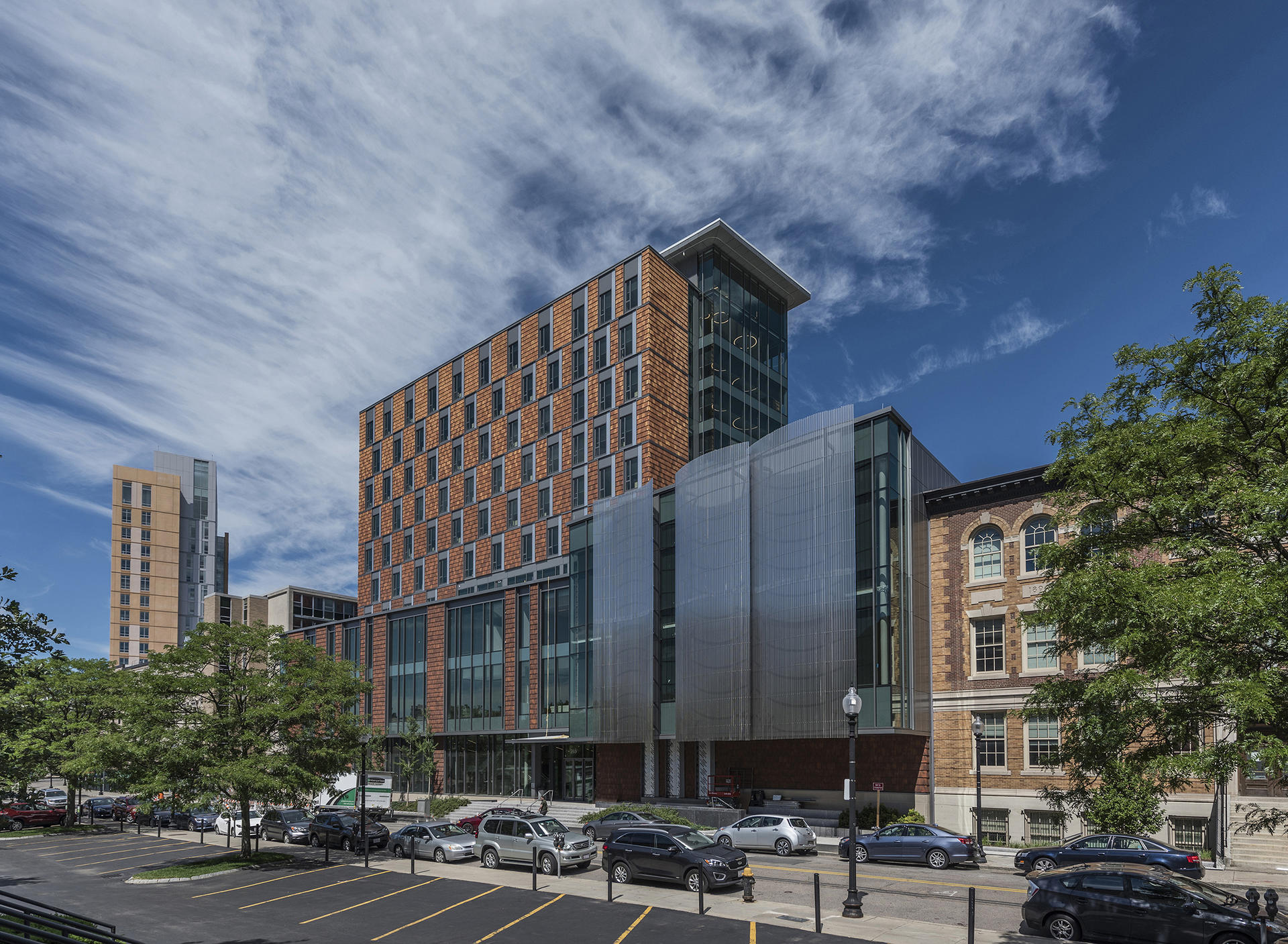At 150 Years, a New Door Opens at NEC
New England Conservatory celebrates 150th anniversary with opening of new Student Life and Performance Center, a state-of-the-art multipurpose facility.

New England Conservatory is celebrating its 150th anniversary with the opening of its Student Life and Performance Center (SLPC), a new hub for performance, practice, and residential life open to the public as part of NEC’s commitment to sharing music with the Boston community. The new building will be dedicated on Thursday, September 14 at 11 a.m. with a formal ribbon-cutting ceremony attended by members of NEC’s board of directors, faculty, students and alumni featuring performances by current NEC students.
Understanding that music is one of the transcendent expressions of human civilization, the SLPC, located in Boston’s Fenway, provides a central resource for both NEC students and the public—to live, socialize and study, with exceptional facilities for rehearsal, performances and recording. Ann Beha Architects, with Gensler, designed the new Center, a distinctly contemporary 10-story building, responding to its historic context. Clad in terra cotta tile with broad expanses of glass, the new building showcases NEC programs and performances. Alongside the Conservatory’s landmark buildings, it creates an architectural ensemble spanning two centuries. The building supports NEC’s commitment to environmental stewardship with sustainable features and new campus landscape.
Kennett F. Burnes, chair of the Board of Trustees of New England Conservatory, said:
“The opening of the Student Life and Performance Center serves as the capstone to our sesquicentennial. We designed the Center with our 750 undergraduate and graduate students in mind. From students enrolled in classical, jazz, voice, to Contemporary Improvisation, the new spaces invite collaboration and community. We also think the students will appreciate having one of the highest student-to-practice-room ratios of any conservatory. Our performance venues and recording studios reflect our commitment to keep pace with Boston’s continued innovation and cultural vibrancy. And our expanded presence in the Fenway serves as an extension of the work we do at our historic concert venue, Jordan Hall, and supports our dynamic community of 1,600 young musicians between the ages of 3–18 enrolled in the Preparatory School.”
Designed to foster collaboration, spark creativity, and nurture a student community, the SLPC includes a three-story “podium” of light-filled common areas. From St. Botolph Street, The Speed Dining Commons, a full-service cafeteria and student dining area, is open to the public and houses The Joseph L. Bower Family Stage, a raised stage to support student-led ensemble performances. The new two-level Blumenthal Family Library brings together the Conservatory's remarkable holdings of print material and audio resources, consolidated in a central, accessible location. It provides climate-controlled storage for rare collections, and offers students group listening sessions in soundproof rooms. The SLPC’s seven stories of residential housing for 256 students doubles the on-campus occupancy for freshmen and sophomores.
The SLPC extends NEC’s long tradition of public engagement through new performance facilities that will serve the community as well as students and faculty. A state-of-the-art black box theatre, orchestra rehearsal room and small ensemble room are designed to present any genre or style of music and utilize floating slab technology and other design considerations to isolate sound. The three multiuse performance spaces are housed in a section of the new building that is independent of all mechanical machinery, making the spaces completely acoustically sound.
Unlike any other venue in the city of Boston, NEC’s new Plimpton Shattuck Black Box Theatre seats 225 and features an operable subfloor to provide various staging and seating configurations. Burnes Hall, an orchestral rehearsal space 50% larger than Jordan Hall’s stage, creates an ideal environment for string instruments with hardwood floors. The Eben Jordan Ensemble Room has the capacity to fit a 20-piece band and serves as a state-of-the-art recording studio, with two isolation booths.
Ann Beha FAIA, Principal of Ann Beha Architects, said:
“The building and its new streetscape welcome students, families, faculty, and the greater musical community to NEC. We created spaces where performance, practice, and daily life are kindred spirits; where learning, relaxation and community are well supported; and where design excellence sets a standard. Designing a building that is both home and workplace, incorporating acoustic excellence, sustainability and construction quality; pragmatic, but dynamic in its design expression and its functions, has been a pleasure.”
Award-winning Boston sculptor David Phillips was commissioned to create artwork for the SLPC. The three pieces, inspired by music, include an aluminum mobile suspended from the ceiling of the building’s gallery which connects to NEC’s St. Botolph building as well as a stainless-steel bench and a 17-foot high stainless steel structure abstracted from a violin’s scroll located in a new park on the corner of St. Botolph and Gainsborough Streets.
Kenneth I. Fisher FAIA, Principal of Gensler, said:
“The great collaborative spirit between NEC, the design and the construction teams successfully realized the vision for a building that stitches the campus together and blends in as a part of Boston’s urban fabric."
Ann Beha Architects also designed the restoration of NEC’s historic Jordan Hall from 1994 to 1995, receiving numerous awards. The SLPC is the Conservatory’s first new construction project in more than 50 years, slated to be LEED Silver certified.
NEC will continue to celebrate its sesquicentennial with special performance programming to be announced in the near future.
We created spaces where performance, practice, and daily life are kindred spirits.
